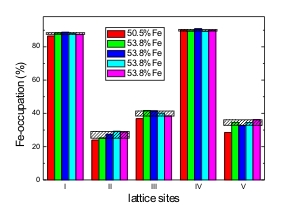Disordered Alloys
| The σ-phase of FeCr appears as precipitates in the α-phase during the steel production, deteriorating the mechanical
and corrosive properties. Whereas at high temperatures the bcc α-phase is stable in the whole concentration range, the σ-phase forms
only in a very restricted concentration and temperature interval. In contrast to the strongly ferromagnetic α-phase, the σ-phase is
only weakly magnetic with ordering temperatures below 50 K vanishing rapidly with increasing Cr-content, what led to the assumption of the presence
of antiferromagnetic components. The reason of this strange behaviour might be due to the very complex structure of the σ-phase.
It is tetragonal (space group D144hP42/mnm) with five crystallographically different lattice sites, which are different both in coordination number and
local symmetry, thus suggesting that different Fe-moments are formed at the different sites. Whereas some theoretical papers state that
Fe occupies only three of the five places, most experimental works indicate the presence of Fe on all five sites, but with nonstatistical distribution.
However, a comparison of the reported values gives quite different results, pointing to a strong influence of the preparation conditions on
the element distribution.
To gain more information on the magnetic ground state of σ-FeCr neutron diffraction (D1A at ILL), magnetic and 57Fe high field Mössbauer investigations on a series of FexCr1-x (x = 0.50-0.56) alloys were performed.As a result a procedure for preparation of samples with reproducible site occupation was developed. Both moment and Curie temperature changes linearly with Fe-concentration. The ratio of saturation to effective moment fits well to the Rhodes-Wohlfarth plot. The change of the spin disorder resistivity is small at the ordering temperature. A non linear relation between moment and hyperfine field points to large valence hyperfine field contributions, varying with the Cr content. From the experimental facts gathered up to now indications exist that the investigated samples of the σ-phase of FeCr might be described as spin fluctuation compounds. |
Fe occupation in σ-FeCr
Fig.1: Fe occupation of the five crystallographically different lattice sites determined from neutron diffraction analysis for five samples prepared in slightly different way |
Contact: M. Reissner, W. Steiner |


